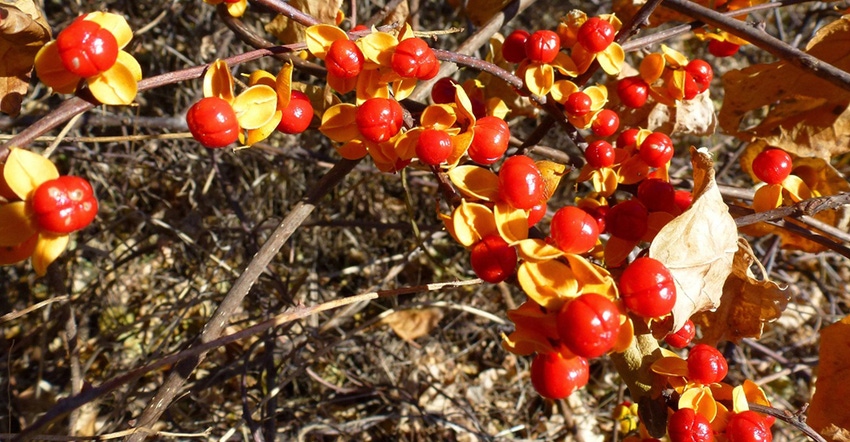November 16, 2017

By Emilie Justen
Attractive vines of Oriental bittersweet, brought to North America from Asia and used as an ornamental plant, have escaped cultivation and become invasive in residential and rural areas in Minnesota.
The woody vine plant is a target weed on Minnesota’s Noxious Weed Eradicate List. Accordingly, it is required by law that all above- and belowground plant parts must be destroyed.
Oriental bittersweet spreads by several means. The persistent red fruit is consumed by birds, which spread the seed to uninfested areas. Look for it where birds perch. The areas beneath the perches may have Oriental bittersweet seedlings, juvenile vines or mature woody vines, and they would be a place to target control efforts.
Humans also spread Oriental bittersweet infestations by physically moving the plants.
Oriental bittersweet was commonly propagated and sold in Minnesota through nurseries and retail garden centers before 2010. Its use in floral arrangements and wreaths also increased its spread.
Despite its ornamental characteristics, Oriental bittersweet is an ecological threat to forests, grasslands and parks in Minnesota. The vines twine around trees, girdling them in a snake-like fashion. Though it prefers forest edges and sunlight, Oriental bittersweet can grow in forest understories, eventually reaching forest canopies, shading the trees and understory, and preventing native plant species from flourishing.
Infestations can become so thick that wildlife, such as deer, can have difficulty navigating through wooded areas filled with Oriental bittersweet.
Oriental bittersweet has identifiable characteristics to help distinguish it from other woody vines. The mature fruit is a red berry with a yellow capsule. The berries are attached along the stem, where the leaves meet the stem. This should not be confused with American bittersweet, which has red berries with orange capsules. Additionally, dense infestations of Oriental bittersweet will give a wooded area a messy, chaotic look.
Recommended management practices for Oriental bittersweet include the following:
• Do not collect and use the fruiting stems for ornamental purposes. Do not plant Oriental bittersweet or propagate any of its plant parts.
• Foliar or cut-stump herbicide applications can be effective. For specific herbicide recommendations, contact a University of Minnesota Regional Extension educator.
• Monitor and treat the plant repeatedly until the seed bank is depleted.
To report infestations of Oriental bittersweet or any other noxious weeds on the MDA eradicate list, notify the MDA by email at [email protected], or voicemail at 888-545-6684 (toll-free).
Justen is on the Noxious and Invasive Weed Team at the Minnesota Department of Agriculture.
You May Also Like




